Warming Up to Snowflake Manufacturing

Brent McPhail is the Founder and Chief Executive Officer of Brave Control Solutions. For modular manufacturers, Brave integrates various robotic components to create machines to manufacture buildings offsite. Given that there are thousands of different robotic components, and that different manufacturers have different needs, it’s no simple matter to design a machine that will work for a specific manufacturer. Here, we look into Brave’s process for helping modular manufacturers introduce automation.
Getting started with robotics
Although more manufacturers are considering automation, McPhail acknowledges it can be intimidating. The first thing Brave Control Solutions does is determine a manufacturer’s automation readiness on a scale of 1 to 4. “Once we know this, we can begin to map out their ‘Gap to Good’. It’s about more than technology,” McPhail explains. “We look at their company culture, their management systems. We determine if they’re practising Lean manufacturing. One of the biggest challenges in construction automation is DfMA [design for manufacturing and assembly]. This term is talked about a lot but really understanding it is essential for an automated system to work effectively.”
Modular manufacturing companies differ greatly in how ready they are for automation. McPhail says some have overly-ambitious ideas about what automation can do for them when they’re nowhere near ready. “It would be like handing them the keys to a rocket ship when they have nobody who can pilot it.”
When a company turns out not to be ready for automation, it can still be valuable for a manufacturing expert to look into its processes. “Sometimes there are ways we can help them manufacture better without adding robots.” For example, Brave can identify bottlenecks, make recommendations for how to move materials, and suggest ways to make their operations more Lean.
When the in-depth assessment is complete, “we can figure out what the low-hanging fruit are” — the places where a factory can most easily, quickly, and effectively automate with a satisfying return on investment.
The low-hanging fruit varies from plant to plant, but McPhail says it’s often related to materials handling. In other cases, workers are wasting too much time walking around. “In traditional manufacturing, the goal is an OEE [overall equipment efficiency] of 85%. You can’t get 85% efficiency if the worker who operates the machinery is wandering around looking for things 60% of the time.”
Walking is the kind of tedious task that it’s a waste of a human’s brain and skills to spend time on. Brave’s goal is to gain maximum efficiency from the manufacturer’s current workforce.
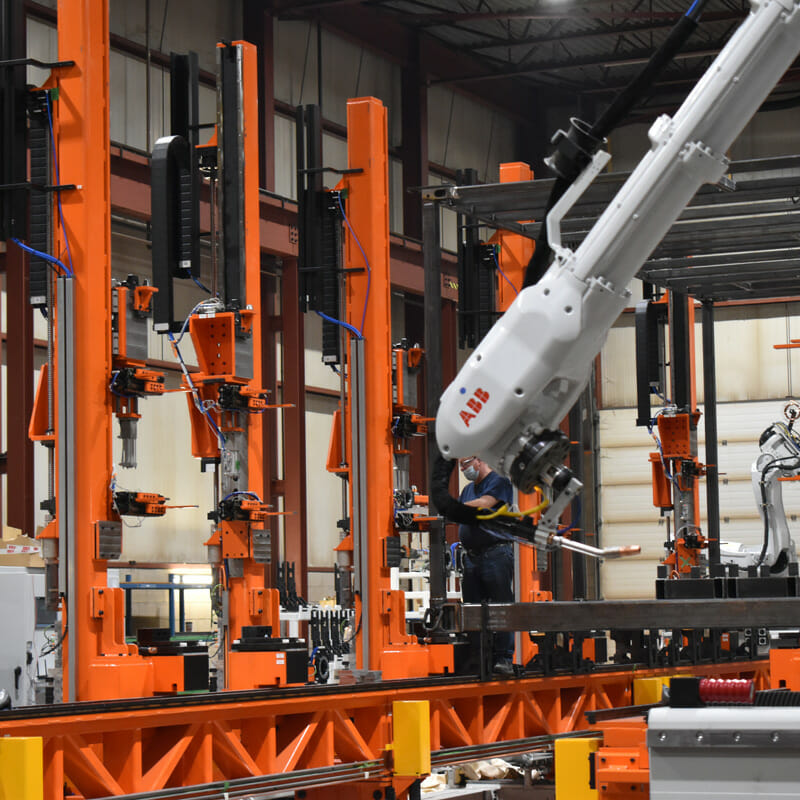
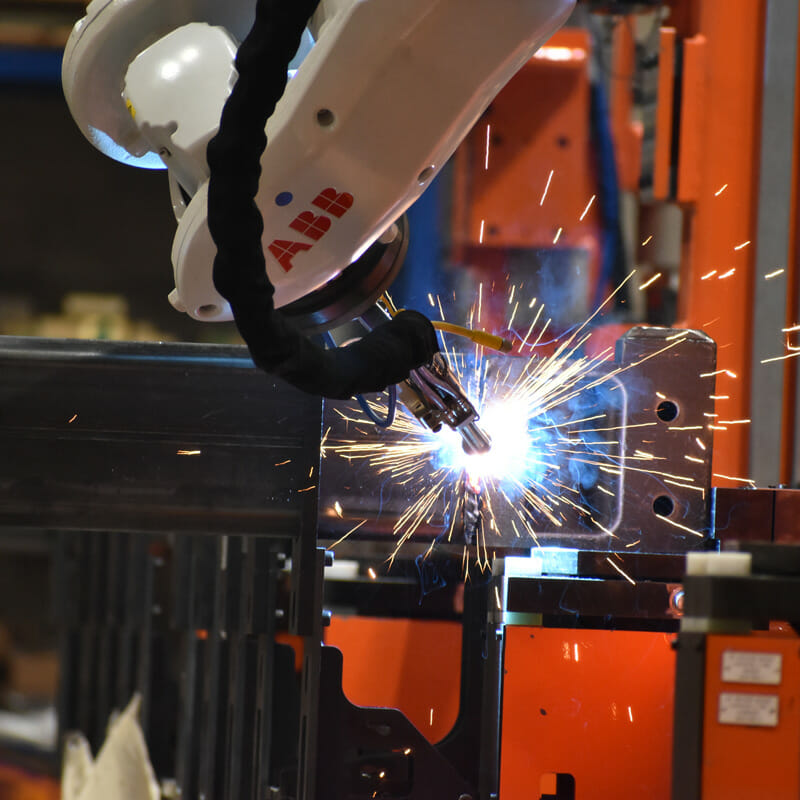
Learn More in this Podcast:
Design for Automated Modular Manufacturing w/ Brave Control Solutions
In this episode of Inside Modular, Brent McPhail, founder and CEO of Brave Control Solutions, returns to discuss the current state of automation within the modular construction industry and what lies ahead as both designers and manufacturers embrace the benefits and challenges of modular automation.
Labor
Contrary to the commonly expressed fear that robots replace workers, McPhail says, “Automation for construction won’t remove a single construction job. It’ll mean we can come closer to meeting the demand for new construction with the existing skilled labor we already have.”
He also says that workers on the factory floor are typically pleased when robots are introduced. “Nobody likes to waste time and energy being inefficient at work,” he says. “If automation can help them produce five or ten times as many drywall sheets per hour, with no greater effort or stress, who wouldn’t want that?”
Ideally, humans do the jobs they’re best at and find most satisfying — and robots do the jobs they’re best at. And that’s often the dull, tedious, repetitive tasks that humans find boring, or heavy-lifting tasks that are unsafe for them to do for long periods. For example, to make the best use of a skilled carpenter’s expertise, “A general laborer can run the machine and the carpenter should be in a supervisory role,” McPhail explains. “The carpenter can make sure the raw material is to specification, and do quality control on the product going out. They know when adjustments need to be made to the system.”
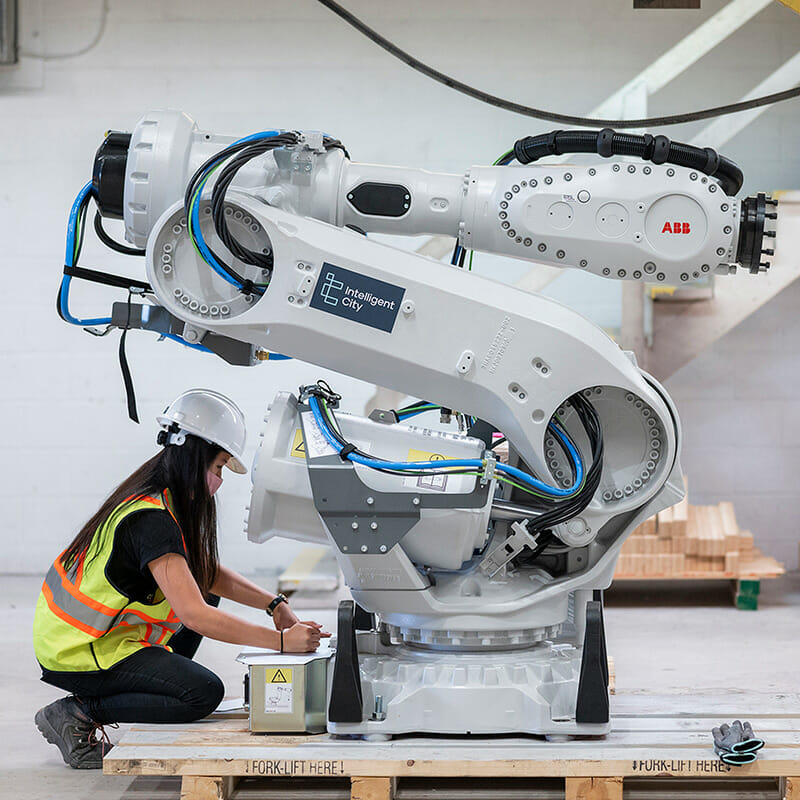
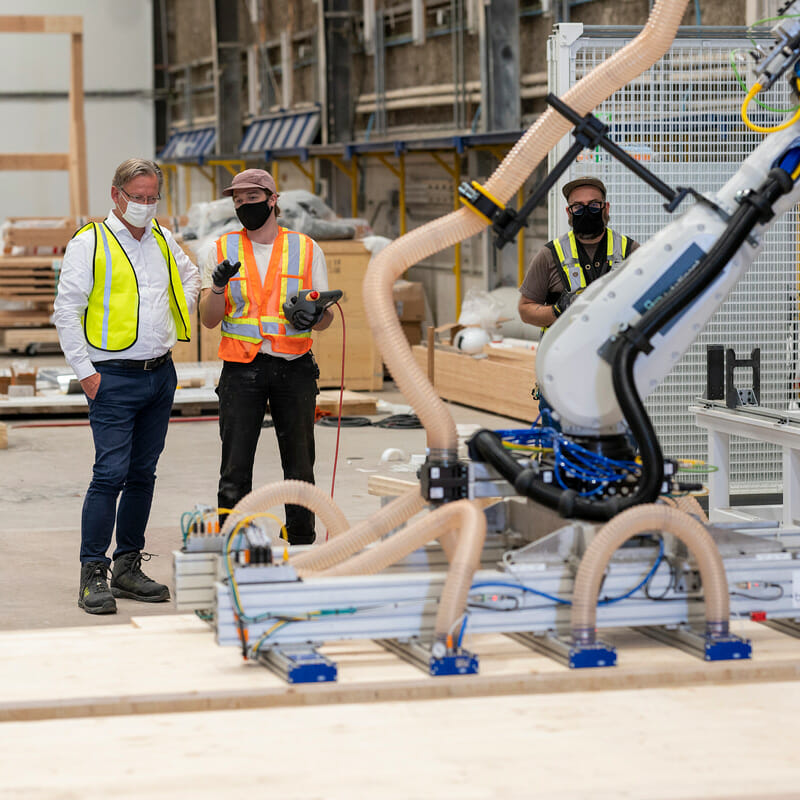
Mature manufacturing and early adopters
As a system integrator, Brave prefers to apply off-the-shelf technology and then customize it for specific tasks. Automated construction is a new field, so they sometimes have to develop original tools which initially might increase risk and lengthen project timelines.
Another complication is what McPhail calls “snowflake manufacturing”. Every building is unique, depending on the requirements of the site and the owner’s needs. In contrast, although there are minor variations between Ford F-150s — such as paint color and seat fabric options — they are basically all the same, down to an incredible level of detail. So the robots in an automotive manufacturing plant can be programmed to do the same thing over and over again.
In contrast, modular manufacturers need enough flexibility in their robotic systems to accommodate snowflake manufacturing. At the same time, they need to accept that any robotic system needs to be designed so that different projects can be made with fundamentally the same equipment. “You’re never going to make a good business case for continually redeveloping the machinery for each new project.”
Design for automated manufacturing
For an automated facility, products need to be designed so robots can manipulate and assemble the parts. If the robots’ constraints mean that manufacturing is “only 70% automated and the rest has to be done manually, then you’re losing efficiencies you should’ve gained with automation.”
In a mature automated industry, knowledge of how to design for automated assembly has been passing from senior to junior designer for 60 years. Designers know where to put the slots and pins and holes on a car component so robots can manipulate it. In the modular industry, that generational knowledge doesn’t exist and, in its absence, architects, robotics experts, and manufacturers all need to consult with one another at the beginning of the design process, so they can all inform the design.
“We build a digital replica of the equipment. The architect can export their Revit model into the digital factory and watch the robots work. If the robot collides with something in the virtual design, the architect can adjust the design to avoid the crash,” McPhail explains. “This trial and error method is inefficient, but at this early-adopter stage, it’s what we have. As the industry develops more automated solutions and gains DfMA experience, the BIM [building information modeling] models will integrate with the automation and eliminate the need for trial and error.”
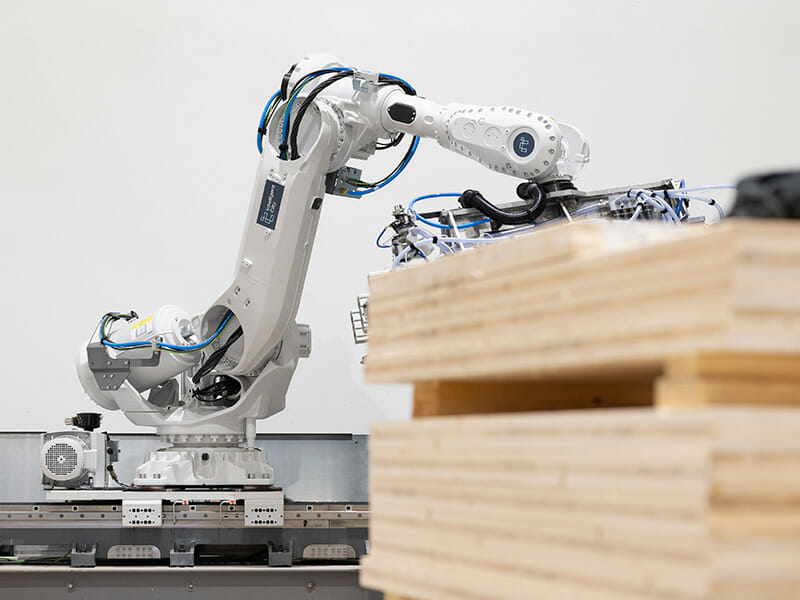
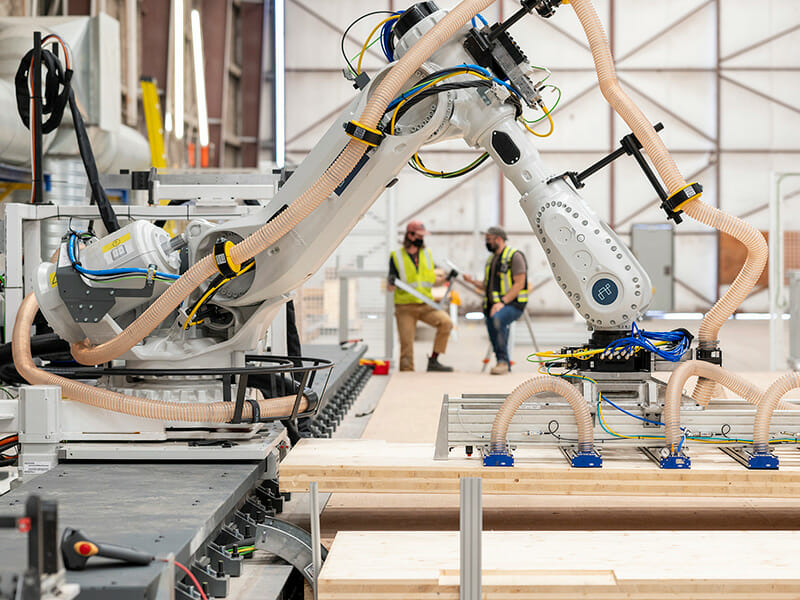
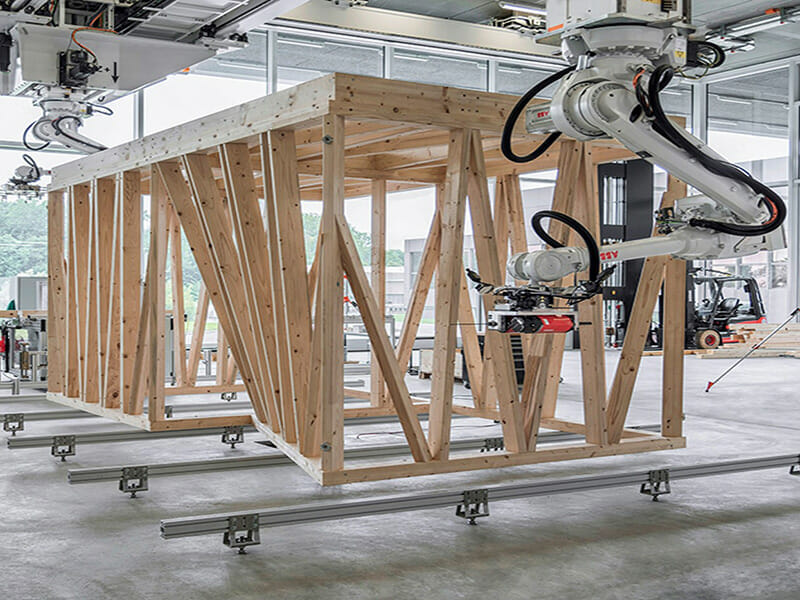
Mobile factories
McPhail doesn’t shy away from considering new ideas, and while his company is currently “building the tools and equipment the modular industry needs, and solving their manufacturing problems” he’s imagining other ways that the industry might adapt to automation in the future.
One suggestion is that automation makes smaller, mobile factories more feasible. Currently, hiring is difficult, so moving a temporary facility from place to place and hiring local people is impractical. McPhail’s alternative idea is to “set up a temporary factory near where you’re going to build 1000 houses. You transport your robotic equipment to the factory, connect it all together, and build those houses. When you’re done, you pack everything up and move it all to the next project site.” In this scenario, there’d be no need for long-distance transportation of modules and no need for a huge, centralized manufacturing plant. Will future modular factories involve robots roaming from jobsite to jobsite?
About the Author: Zena Ryder is a freelance writer, specializing in writing about construction and for construction companies. You can find her at Zena, Freelance Writer or on LinkedIn.
More from Modular Advantage
Resia: Breaking All the Rules
Resia Manufacturing, a division of U.S.-based Resia, is now offering prefabricated bathroom and kitchen components to industry partners. Its hybrid fabrication facility produces more precise bathroom and kitchen components (modules) faster and at lower cost than traditional construction. Here’s how Resia Manufacturing does it.
How LINQ Modular Innovates to Bring Modular To The Market in the UAE and Beyond
LINQ Modular, with an office and three manufacturing facilities in Dubai, is a modular firm based in United Arab Emirates. The company is on a mission: to break open the housing and construction markets in the Gulf Cooperation Council (GCC) area with modular.
ModMax: Redefining Modular Construction with Confidence and Precision
ModMax was born out of frustration—frustration with five persistent pain points in modular construction: Permitting bottlenecks. Production delays. Rigid designs. Disconnect between “the office” and the field. Lack of transparency and communication.
LifeArk: Disaster-Resilient Housing from Recycled Plastic and 100-year-old Technology
Wee compares LifeArk’s housing units to Yeti coolers, as they are built similarly. Each component takes 15 to 20 minutes to manufacture, has an R-value of 40, and includes molded slots and chases for wiring, plumbing, fire sprinklers, and other utilities.
Building the Future of Modular Edge Infrastructure
The edge data center market is expanding rapidly, driven by the surge in AI workloads, IoT adoption, and the need for localized compute power. In these environments, sustainability, scalability, and reliability are non-negotiable. Cooling is among the most complex challenges for operators—and one of the most decisive factors in long-term success.
Accelerating Light-Gauge Steel Construction: A Semi-Automated Digital Workflow for Off-Site Projects
For construction professionals, the message is clear. By adopting semi-automation and digitalization, companies can deliver projects faster, more accurately, and more profitably, while also building stronger collaboration across teams. The approach is not about replacing people with machines, but about empowering people with better tools and processes.
Why Modular Data Centers Are Gaining Momentum
Artificial intelligence, high-performance computing, and edge applications push the limits of traditional “stick-built” data centers. They take years build, often struggle with high density workloads, and aren’t optimized for deployments near end users. Modular data center platforms are purpose-built to address these challenges, offering flexibility and scalability to adapt to evolving technologies, while opening new opportunities for the modular construction industry.
Supply Chain Innovation in Action: 5 Habits Every Modular Leader Should Practice
By applying these principles to supply chain practices — collaborative planning, strategic procurement, scenario modeling, digital tools, and transparent forecasting — construction leaders can build value chains that are not just efficient and agile, but truly innovative.
Exploring the Role of Modular Integrated Construction (MiC) in Advancing Circular City Principles – A Survey of Stakeholder Perspectives
The survey findings highlight the significant potential of Modular integrated Construction (MiC) in advancing the development of circular cities. By reducing costs, accelerating construction timelines, and minimizing waste generation, MiC offers a promising approach to sustainable urban development.
The Use of MS POLYMER™-Based Sealants and Adhesives in Modular Building
These products combine flexibility and elastic recovery with excellent adhesion to different substrates and have already shown their usefulness in traditional construction. Now it’s time for them to be put to use in the modular construction industry.










